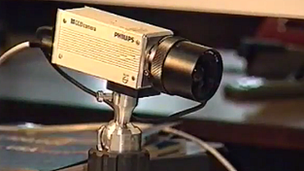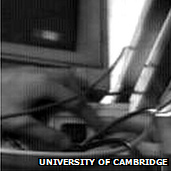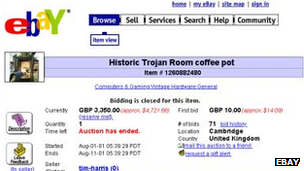How the world's first webcam made a coffee pot famous
- Published

The original webcam updated the image of a coffee pot about three times a minute
Computer technology now moves so fast it's hard to remember life before the internet. But just 19 years ago at the beginning of the nineties, the fledgling world wide web had no search engines, no social networking sites, and no webcam.
The scientists credited with inventing the first webcam - thereby launching the revolution that would bring us video chats and live webcasts - stumbled upon the idea in pursuit of something far more old-fashioned: hot coffee.
As computer geeks at the University of Cambridge beavered away on research projects at the cutting edge of technology, one piece of equipment was indispensable to the entire team - the coffee percolator.

The researchers rigged up a small Philips camera to provide the pictures
"One of the things that's very, very important in computer science research is a regular and dependable flow of caffeine," explains Dr Quentin Stafford-Fraser.
But the problem for scientists was that the coffee pot was stationed in the main computer lab, known as the Trojan room, and many of the researchers worked in different labs and on different floors.
"They would often turn up to get some coffee from the pot, only to find it had all been drunk," Dr Stafford-Fraser remembers.
Streaming coffee
To solve the problem, he and another research scientist, Dr Paul Jardetzky, rigged up a camera to monitor the Trojan room coffee pot.
The camera would grab images three times a minute, and they wrote software that would allow researchers in the department to run the images from the camera on their internal computer network.
This removed the need for any physical effort to check the coffee pot, and avoided the emotional distress of turning up to find it empty.
However, it wasn't until 22 November 1993 that the coffee pot cam made it onto the world wide web.
Once again it was a computer scientist, momentarily distracted from his research project, who made the breakthrough.
BBC Look East's original report into the pioneering webcam from May 1998
Dr Martyn Johnson was not one of those connected to the internal computer network at the Cambridge lab, and therefore had been unable to run the coffee pot cam software.
He had been studying the capabilities of the web and upon investigating the server code, thought it looked relatively easy to make it run.
"I just built a little script around the captured images," he says.
"The first version was probably only 12 lines of code, probably less, and it simply copied the most recent image to the requester whenever it was asked for."
And so it was that the grainy images of a rather grubby coffee pot in a university lab were written into computer science folklore, as the first ever webcam.
East of Java
"It didn't vary very much," explains Dr Stafford-Fraser. "It was either an empty coffee pot, or a full one, or in more exciting moments, maybe a half-full coffee pot and then you'd have to try and guess if it was going up or down."
Word got out, and before long millions of tech enthusiasts from around the world were accessing images of the Trojan room coffee pot.
Dr Stafford-Fraser remembers receiving emails from Japan asking if a light could be left on overnight so that the pot could be seen in different time zones.
The Cambridge Tourist Information office had to direct visitors from the US to the computer lab to see it for themselves.

The final image broadcast over the webcam feed
The coffee pot cam even got a mention on the BBC's longest running radio soap opera - the Archers.
"I think we were all a little bewildered by it all to be honest," confesses Dr Johnson.
"I sometimes think nothing else I'm ever involved in again in my life will get this much coverage and it was just one afternoon's crazy idea," adds Dr Stafford-Fraser.
Die Kaffeekanne
Ten years and millions of hits later, the scientists wanted to move on.
"The software was becoming completely unmaintainable," remembers Dr Johnson.
"Research software is not always of the highest quality and we simply wanted to throw away the machines that were supporting this."
Despite a wave of nostalgic protest from webcam fans around the world, the coffee pot and the webcam were eventually switched off.
The last image captured was the scientists' fingers pressing the "off" button.

The coffee pot attracted 71 bids before selling for £3,350 on auction site eBay
"In 10 years it had gone from being a wacky new idea, to a novelty that a reasonable number of people knew about, to a widely viewed icon of the early web, to an historic artefact, and then to something that people were mourning over when it was no longer there," concludes Dr Stafford-Fraser.
"Only on the internet can that sort of thing happen in just a few years."
The Trojan room coffee pot was sold at auction - predictably over the internet - for £3,350.
It was bought by Der Spiegel news magazine in Germany, which soon pressed the pot back into active service.
Rebecca Kesby's report on the creators of the world's first webcam airs on the BBC World Service's Witness programme on 23 November. You can download a podcast of the programme or browse the archive.
- Published10 November 2012
- Published26 September 2012
- Published26 January 2012